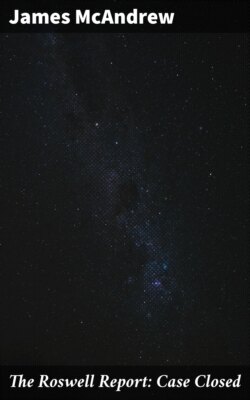Читать книгу The Roswell Report: Case Closed - James McAndrew - Страница 16
На сайте Литреса книга снята с продажи.
High Altitude Polyethylene Research Balloons
ОглавлениеIn 1946, as a result of research conducted for project Mogul, Charles B. Moore, a New York University graduate student working under contract for the U.S. Army Air Forces, made a significant technological discovery: the use of polyethylene for high altitude balloon construction.[71] Polyethylene is a lightweight plastic that can withstand stresses of a high altitude environment that differed drastically from, and greatly exceeded, the capabilities of standard rubber weather balloons used previously. Moore’s discovery was a breakthrough in technology. For the first time, scientists were able to make detailed, sustained studies of the upper atmosphere. Polyethylene balloons, first produced in 1947 for Project Mogul, are still widely used today for a host of scientific applications.
High altitude polyethylene balloons and standard rubber weather balloons differ greatly in size, construction, and utility. The difference between these two types of balloons historically has been the subject of misunderstandings in that the term “weather balloon” is often used to describe both types of balloons.
High altitude polyethylene balloons are used to transport scientific payloads of several pounds to several tons to altitudes of nearly 200,000 feet. Polyethylene balloons do not increase in size and burst with increases in volume as they rise, as do standard rubber weather balloons. They are launched with excess capacity to accommodate the increase in volume. This characteristic of polyethylene balloons makes them substantially more stable than rubber weather balloons and capable of sustained constant level flight, a requirement for most scientific applications.
Fig. 48. Relative sizes of a modern high altitude polyethylene research balloon, an airliner, and a hot-air balloon. Inaccurate characterizations of the giant high altitude research balloons as “weather balloons” (which are typically 15 feet in diameter) has historically been the source of confusion. (courtesy of Mike Smith, Raven Industries) Raven Industries 40 million cubic foot balloon. 450 ft in diameter at 130,000 feet DC-9 airliner 104 ft long Hot-air balloon. 50 ft in diameter
The initial polyethylene balloons had diameters of only seven feet and carried payloads of five pounds or less.[72] As balloon technology advanced, payload capacities and sizes of balloons increased. Modern polyethylene balloons, some as long as several football fields when on the ground, expand at altitude to volumes large enough to contain many jet airliners. Polyethylene balloons flown by the U.S. Air Force have reached altitudes of 170,000 feet and lifted payloads of 15,000 pounds.[73]
During the late 1940’s and 1950’s, a characteristic associated with the large, newly invented, polyethylene balloons, was that they were often misidentified as flying saucers.[74] During this period, polyethylene balloons launched from Holloman AFB, generated flying saucer reports on nearly every flight.[75] There were so many reports that police, broadcast radio, and newspaper accounts of these sightings were used by Holloman technicians to supplement early balloon tracking techniques.[76] Balloons launched at Holloman AFB generated an especially high number of reports due to the excellent visibility in the New Mexico region. Also, the balloons, flown at altitudes of approximately 100,000 feet, were illuminated before the earth during the periods just after sunset and just before sunrise. In this instance, receiving sunlight before the earth, the plastic balloons appeared as large bright objects against a dark sky. Also, with the refractive and translucent qualities of polyethylene, the balloons appeared to change color, size, and shape.
The large balloons generated UFO reports based on their radar tracks.[77] This was due to large metallic payloads that weighed up to several tons and echoed radar returns not usually associated with balloons. In later years, balloons were equipped with altitude and position reporting transponders and strobe lights that greatly diminished the numbers of both visual and radar UFO sightings.
One classic misidentification of a Holloman balloon that was mistaken for a UFO, was launched on October 27, 1953.[78] According to the following account published in a widely distributed 1958 history of Air Force balloon operations, Contributions of Balloon Operations to Research and Development at the Air Force Missile Development Center Holloman Air Force Base, N. Mex. 1947–1958, a suspected Holloman balloon was tracked both visually and by radar over London, England on November 3, 1953.
“English accounts of the incident contained such statements as ‘tremendous speed,’ ‘practically motionless,’ ‘circular or spherical and white in color,’ ‘emitting or reflecting a fierce light.’ Altitude was reported as 61,000 feet—and as no research balloon had recently been sent up from Britain, there was ample room for local saucer enthusiasts to claim the ‘unidentified flying object’ as proof of their theories. A much likelier explanation, however, is that this was really the balloon launched from Holloman on 27 October.”[79]
